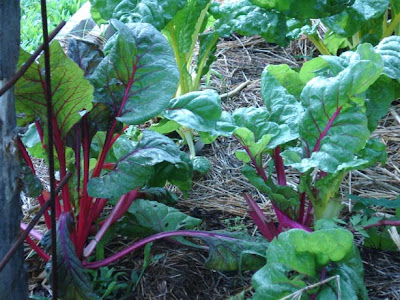If you planted a tomato into virgin Australian soil (and probably most other virgin soils) and watered it, it might live and produce small tomatoes, but it wouldn't thrive. To get the best from your plants you need to help them along. The old saying of organic farmers world wide is "feed the soil, not the plant" and by this they mean it's best to add old cow, horse, sheep, goat, pig manure, compost or organic matter to improve soil structure and add microbes to the soil, than it is to fertilise plants in unimproved soil. If you're going to be gardening for many years, even sandy and clay soil will improve with these additions, and it's better to garden in soil that's alive and healthy rather than just use the top layer that you add each year.
Once you've improved your soil, and even when you're in the process of doing it, you'll be able to plant up a wide variety of vegetables that will take advantage of your work and result in healthy, organic produce for your table. Fertilising is one of the skills of organic vegetable gardening. It's worthwhile giving this a bit of thought because if you get this right, you'll be looking at abundant crops rather than meagre ones.
One of the good things about organic fertilisers is that many of them can be made in your own backyard, and will therefore cut down the cost of your garden. Garden and kitchen waste can be turned into compost or fed to worms, you can grow comfrey to make a nitrogen-rich tea. Comfrey also breaks down the soil it grows in by sending down a long tap root to mine the minerals contained deep within the soil. Most of those minerals will be in your fertiliser. Aged chicken or animal manure, and manure mixed into compost, make fantastic soil additives and will increase the amount of available nitrogen and microbes in your soil.
Foliar feeding is the fertilising of plants through their leaves. You do it by making or buying a liquid fertiliser to the required strength and, using a watering can, pour the liquid over the plant. Plants can absorb a large amount of their nutrients through their leaves. However, some plants do not like this form of fertilising - tomatoes, pumpkins and zucchini come to mind, but most leafy green vegetables love liquid fertiliser.
When making up a commercial liquid fertiliser, be guided by the instructions on the bottle, but make it weaker than they suggest. A weaker brew, applied more frequently, is a better option. So, for example, if they recommend 1 cap full of fertiliser in 10 litres (quarts) of water, applied every month, make yours ½ cupful in 10 litres and apply it every two weeks. You will get better growth that way.
Leafy greens
Leafy greens usually need to grow fast for better taste. Lettuce, spinach, silverbeet, cabbage etc will do really well if you plant them in rich soil, full of compost, aged animal manures and organic matter, and water them every week or two with a weak compost, worm or comfrey tea, or fish emulsion. So with leafy greens you can give them nitrogen in the soil and a foliar feed over their leaves to keep them growing fast.
Fruiting vegetables - tomatoes, cucumbers, pumpkins etc
They will do better if you plant them in rich soil with an application of sulphate of potash to the planting hole. When you plant the seedling or when the seedling emerges, water it with a solution of seaweed tea, made according to the instructions on the bottle. This is more a plant tonic than a fertiliser and it will help your plants cope with a wide range of conditions as well as help them access the available nutrients in the soil and grow good root systems. Don't give fruiting vegetables too much nitrogen and don't give them foliar fertiliser because they'll grow a lot of leaves but give you no fruit. The line is fine here - you want a good healthy plant capable of supporting strong growth and fruit but you don't want to over do it. So good soil + seaweed + watering around the base of the plants - don't water these plants over their leaves, you'll be inviting trouble if you do.
If you have any worm castings, put some in the planting hole or around the base of the plant later on, and cover it with mulch, or make worm tea. The instructions for doing that is in the link below for home made fertilisers.
If you're hoping to make your own nitrogen fertilisers, I encourage you to get some comfrey root and plant it at the edge of your garden or in a large pot. Comfrey leaves can be used for several purposes in the garden - to make nitrogen fertiliser tea, as a mulch for potatoes and to accelerate decomposition in the compost heap. It's a valuable herb. Many people think it's an invasive plant, and it is in a way but it won't take over your garden. It's a clumping plant and it will stay in the area you give it, but if you decide to remove it, any little piece left behind will reshoot. So make sure you give it a permanent position, or plant in a container.
Organic fertilisers
My home made fertiliser recipes
Growing tomatoes from seed
There are many other nutrients necessary in the garden but the fertilisers above are the main ones and they'll get you started. In a couple of years, when you want to learn more about fertilisers, find a good book about organic fertilising and do some reading. It's an interesting subject. And remember, soil improvement and fertilising are ongoing tasks, just like watering and pruning, and are part of every gardening season.




